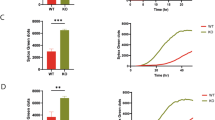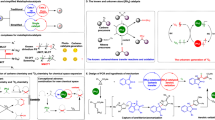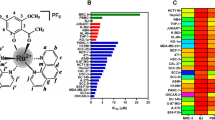Abstract
The photosensitizer 9-capronyloxytetrakis (methoxyethyl) porphycene localizes predominantly in the endoplasmic reticulum (ER) and, to a lesser extent, in mitochondria of murine leukemia L1210 cells. Subsequent irradiation results in the loss of ER > mitochondrial Bcl-2 and an apoptotic response. Although an increase in cytosolic Ca2+ was observed after irradiation, apoptosis was not inhibited by either the presence of the calcium chelator BAPTA or by the mitochondrial uniporter inhibitor ruthenium amino binuclear complex (Ru360). Moreover, neither reagent prevented the loss of Bcl-2. Ruthenium red (RR) devoid of Ru360 prevented Bcl-2 loss, release of Ca2+ from the ER and the initiation of apoptosis. Since RR was significantly more sensitive than Ru360 to oxidation by singlet oxygen, we attribute the protective effect of RR to the quenching of reactive oxygen species. Although cytosolic and (to a lesser extent) mitochondrial Ca2+ levels were elevated after photodynamic therapy, these changes were apparently insufficient to contribute to the development of apoptosis.
Similar content being viewed by others
Log in or create a free account to read this content
Gain free access to this article, as well as selected content from this journal and more on nature.com
or
Abbreviations
- AM:
-
acetoxymethyl ester
- BAPTA-AM:
-
(acetyoxymethyl)-1,2-bis(o-amino phenoxy)ethane N,N,N′,N′-tetra (acetoxymethyl)ester
- CPO:
-
9-capronyloxytetrakis (methoxyethyl) porphycene
- DCF:
-
2′,7′-dichlorofluorescein
- DEVD-R110:
-
asp-glu-val-asp-rhodamine 110
- ER:
-
endoplasmic reticulum
- ERTr:
-
endoplasmic reticulum tracker
- FHS:
-
Fischer's medium with 20 mM HEPES buffer pH 7.2 replacing NaHCO3
- H2DCF:
-
dichlorohydrofluorescein
- H2DCFDA:
-
dichlorodihydrofluorescein diacetate
- LTB:
-
lysotracker blue
- NAO:
-
nonyl acridine orange
- NPe6:
-
N-aspartyl chlorin e6
- PDT:
-
photodynamic therapy
- ROS:
-
reactive oxygen species
- RR:
-
ruthenium red
- Ru360:
-
ruthenium amino binuclear complex
- SnET2:
-
tin etiopurpurin
- THP:
-
thapsigargin
- TMRM:
-
tetramethylrhodamine methyl ester
- Trolox:
-
6-Hydroxy-2,5,7,8- tetramethylchroman-2-carboxylic acid (water-soluble derivative of Vitamin E)
- ΔΨm:
-
mitochondrial membrane potential
References
Dougherty TJ, Gomer CJ, Henderson BW, Jori G, Kessel D, Korbelik M, Moan J and Peng Q (1998) Photodynamic therapy. J. Natl. Cancer Inst. 90: 889–905
Oleinick NL, Morris RL and Belichenko I (2002) The role of apoptosis in response to photodynamic therapy: what, where, why, and how. Photochem. Photobiol. Sci. 1: 1–21
Kessel D and Castelli M (2001) Evidence that Bcl-2 is the target of three photosensitizers that induce a rapid apoptotic response. Photochem. Photobiol. 74: 318–322
Teiten MH, Bezdetnaya L, Morliere P, Santus R and Guillemin F (2003) Endoplasmic reticulum and Golgi apparatus are the preferential sites of Foscan localisation in cultured tumour cells. Br. J. Cancer 88: 146–152
Teiten MH, Marchal S, D'Hallewin MA, Guillemin F and Bezdetnaya L (2003) Primary photodamage sites and mitochondrial events after Foscan photosensitization of MCF-7 human breast cancer cells. Photochem. Photobiol. 78: 9–14
Kessel D and Luo Y (1999) Photodynamic therapy: a mitochondrial inducer of apoptosis. Cell Death Differ. 6: 28–35
Grebenova D, Kuzelova K, Smetana K, Pluskalova M, Cajthamlova H, Marinov I, Fuchs O, Soucek J, Jarolimand P and Hrkal Z (2003) Mitochondrial and endoplasmic reticulum stress-induced apoptotic pathways are activated by 5-aminolevulinic acid-based photodynamic therapy in HL60 leukemia cells. J. Photochem. Photobiol. B 69: 71–85
Ricchelli F, Barbato P, Milani M, Gobbo S, Salet C and Moreno G (1999) Photodynamic action of porphyrin on Ca2+ influx in endoplasmic reticulum: a comparison with mitochondria. Biochem. J. 338 (Part 1): 221–227
Reiners Jr. JJ, Caruso JA, Mathieu P, Chelladurai B, Yin XM and Kessel D (2002) Release of cytochrome c and activation of pro-caspase-9 following lysosomal photodamage involves Bid cleavage. Cell Death Differ. 9: 934–944
Kessel D, Luo Y, Mathieu P and Reiners Jr. JJ (2000) Determinants of the apoptotic response to lysosomal photodamage. Photochem. Photobiol. 71: 196–200
Castelli M, Reiners Jr. JJ and Kessel D (2004) A mechanism for the proapoptotic activity of ursodeoxycholic acid: effects on Bcl-2 conformation. Cell Death Differ. 11: 905–914
Xue LY, Chiu SM and Oleinick NL (2001) Photochemical destruction of the Bcl-2 oncoprotein during photodynamic therapy with the phthalocyanine photosensitizer Pc 4. Oncogene 20: 3420–3427
Usuda J, Azizuddin K, Chiu SM and Oleinick NL (2003) Association between the photodynamic loss of Bcl-2 and the sensitivity to apoptosis caused by phthalocyanine photodynamic therapy. Photochem. Photobiol. 78: 1–8
Granville DJ, Ruehlmann DO, Choy JC, Cassidy BA, Hunt DW, van Breemen C and McManus BM (2001) Bcl-2 increases emptying of endoplasmic reticulum Ca2+ stores during photodynamic therapy-induced apoptosis. Cell Calcium 30: 343–350
Germain M and Shore GC (2003) Cellular distribution of Bcl-2 family proteins. Sci. STKE 173: pe10
Demaurex N and Distelhorst C (2003) Cell biology. Apoptosis – the calcium connection. Science 300: 65–67
Breckenridge DG, Germain M, Mathai JP, Nguyen M and Shore GC (2003) Regulation of apoptosis by endoplasmic reticulum pathways. Oncogene 22: 8608–8618
Thomenius MJ and Distelhorst CW (2003) Bcl-2 on the endoplasmic reticulum: protecting the mitochondria from a distance. J. Cell Sci. 116: 4493–4499
Thomenius MJ, Wang NS, Reineks EZ, Wang Z and Distelhorst CW (2003) Bcl-2 on the endoplasmic reticulum regulates Bax activity by binding to BH3-only proteins. J. Biol. Chem. 278: 6243–6250
Kruman II and Mattson MP (1999) Pivotal role of mitochondrial calcium uptake in neural cell apoptosis and necrosis. J. Neurochem. 72: 529–540
Smaili SS, Hsu YT, Carvalho AC, Rosenstock TR, Sharpe JC and Youle RJ (2003) Mitochondria, calcium and pro-apoptotic proteins as mediators in cell death signaling. Braz. J. Med. Biol. Res. 36: 183–190
Hajnoczky G, Davies E and Madesh M (2003) Calcium signaling and apoptosis. Biochem. Biophys. Res. Commun. 304: 445–454
Nutt LK, Pataer A, Pahler J, Fang B, Roth J, McConkey DJ and Swisher SG (2002) Bax and Bak promote apoptosis by modulating endoplasmic reticular and mitochondrial Ca2+ stores. J. Biol. Chem. 277: 9219–9225
Kuo TH, Kim HR, Zhu L, Yu Y, Lin HM and Tsang W (1998) Modulation of endoplasmic reticulum calcium pump by Bcl-2. Oncogene 17: 1903–1910
Zazueta C, Sosa-Torres ME, Correa F and Garza-Ortiz A (1999) Inhibitory properties of ruthenium amine complexes on mitochondrial calcium uptake. J. Bioenerg. Biomembr. 31: 551–557
Bae JH, Park JW and Kwon TK (2003) Ruthenium red, inhibitor of mitochondrial Ca2+ uniporter, inhibits curcumin-induced apoptosis via the prevention of intracellular Ca2+ depletion and cytochrome c release. Biochem. Biophys. Res. Commun. 303: 1073–1079
Robertson FM, Beavis AJ, Oberyszyn TM, O'Connell SM, Dokidos A, Laskin DL, Laskin JD and Reiners Jr. JJ (1990) Production of hydrogen peroxide by murine epidermal keratinocytes following treatment with the tumor promoter 12-O-tetradecanoylphorobol-13-acetate. Cancer Res. 50: 6020–6067
Kessel D and Castelli M (2001) Evidence that Bcl-2 is the target of mitochondrial photosensitizers. Photochem. Photobiol. 74: 319–322
Nutt LK, Chandra J, Pataer A, Fang B, Roth JA, Swisher SG, O'Neil RG and McConkey DJ (2002) Bax-mediated Ca2+ mobilization promotes cytochrome c release during apoptosis. J. Biol. Chem. 277: 20301–20308
Matlib MA, Zhou Z, Knight S, Ahmed S, Choi KM, Krause-Bauer J, Phillips R, Altschuld R, Katsube Y, Sperelakis N and Bers DM (1998) Oxygen-bridged dinuclear ruthenium amine complex specifically inhibits Ca2+ uptake into mitochondria in vitro and in situ in single cardiac myocytes. J. Biol. Chem. 273: 10223–10231
Bassik M, Scorrano L, Oakes SA, Pozzan T and Korsmeyer SJ (2004) Phosphorylation of Bcl-2 regulates ER Ca2+ homeostasis and apoptosis. EMBO J. 23: 1207–1216
Chamberlain BK, Volpe P and Fleischer S (1984) Inhibition of calcium-induced calcium release from purified cardiac sarcoplasmic reticulum vesicles. J. Biol. Chem. 259: 7547–7553
Gupta MP, Innes IR and Dhalla NS (1988) Responses of contractile function to ruthenium red in rat heart. Am. J. Physiol. 255: H1414–H1420
Vassilev PM, Kanazirska MP, Charamella LJ, Dimitrov NV and Tien HT (1987) Changes in calcium channel activity in membranes from cis-diamminedichlorophlatinum (II)-resistant and -sensitive L1210 cells. Cancer Res. 47: 519–522
Reed KC and Bygrave FL (1974) A low molecular weight ruthenium complex inhibitory to mitochondrial Ca2+ transport. FEBS Lett. 46: 109–114
Kessel D and Luo Y (1996) Delayed oxidative photodamage induced by photodynamic therapy. Photochem. Photobiol. 64: 601–604
Luo Y, Chang CK and Kessel D (1996) Rapid initiation of apoptosis by photodynamic therapy. Photochem. Photobiol. 63: 528–534
Carry MM, Mrak RE, Murphy ML, Peng CF, Straub KD and Fody EP (1989) Reperfusion injury in ischemic myocardium: protective effects of ruthenium red and of nitroprusside. Am. J. Cardiovasc. Pathol. 2: 335–344
Groskreutz JL, Bronk SF and Gores GJ (1992) Ruthenium red delays the onset of cell death during oxidative stress of rat hepatocytes. Gastroenterology 102: 1030–1038
Meinicke AR, Bechara EJ and Vercesi AE (1998) Ruthenium red-catalyzed degradation of peroxides can prevent mitochondrial oxidative damage induced by either tert-butyl hydroperoxide or inorganic phosphate. Arch. Biochem. Biophys. 349: 275–280
Meinicke AR, Zavan SS, Ferreira AM, Vercesi AE and Bechara EJ (1996) The calcium sensor ruthenium red can act as a Fenton-type reagent. Arch. Biochem. Biophys. 328: 239–244
Caruso JA, Mathieu PA, Joiakim A, Leeson B, Kessel D, Sloane BF and Reiners Jr. JJ (2004) Differential susceptibilities of murine hepatoma 1c1c7 and Tao cells to the lysosomal photosensitizer NPe6: Influence of aryl hydrocarbon receptor on lysosomal fragility and protease contents. Mol. Pharmacol. 65: 1016–1028
Stoka V, Turk B, Schendel SL, Kim T-H, Cirman T, Snipas SJ, Ellerby LM, Bredesen D, Freeze H and Abrahamson M (2001) Lysosomal protease pathways to apoptosis: cleavage of Bid, not pro-caspases, is the most likely route. J. Biol. Chem. 276: 3149–3157
Kessel D, Castelli M and Reiners Jr. JJ (2002) Apoptotic response to photodynamic therapy versus the Bcl-2 antagonist HA14-1. Photochem. Photobiol. 76: 314–319
Gottlieb RA and Adachi S (2000) Nitrogen cavitation for cell disruption to obtain mitochondria from cultured cells. Methods Enzymol. 322: 213–221
Annis MG, Zamzami N, Zhu W, Penn LZ, Kroemer G, Leber B and Andrews DW (2001) Endoplasmic reticulum localized Bcl-2 prevents apoptosis when redistribution of cytochrome c is a late event. Oncogene 20: 1939–1952
Acknowledgements
We thank Ann Marie Santiago, Brendan Leeson and Patricia Mathieu for excellent technical assistance, and Dr H-R Kim for helpful discussions. This work was supported by grants CA23378, CA92618 (DK) and ES009392 (JJR) awarded by the National Institutes of Health and aided by the Cell Culture and Imaging & Cytometry Facility Cores supported by Grant P30 ES06639.
Author information
Authors and Affiliations
Corresponding author
Additional information
Edited by RA Knight
Rights and permissions
About this article
Cite this article
Kessel, D., Castelli, M. & Reiners, J. Ruthenium red-mediated suppression of Bcl-2 loss and Ca2+ release initiated by photodamage to the endoplasmic reticulum: scavenging of reactive oxygen species. Cell Death Differ 12, 502–511 (2005). https://doi.org/10.1038/sj.cdd.4401579
Received:
Revised:
Accepted:
Published:
Issue date:
DOI: https://doi.org/10.1038/sj.cdd.4401579
Keywords
This article is cited by
-
In vitro effect of curcumin-mediated antimicrobial photodynamic therapy on fibroblasts: viability and cell signaling for apoptosis
Lasers in Medical Science (2021)
-
Excessive Selenium Supplementation Induced Oxidative Stress and Endoplasmic Reticulum Stress in Chicken Spleen
Biological Trace Element Research (2016)
-
Assessment of the effect of laser irradiations at different wavelengths (660, 810, 980, and 1064 nm) on autophagy in a rat model of mucositis
Lasers in Medical Science (2015)
-
Photofrin binds to procaspase-3 and mediates photodynamic treatment-triggered methionine oxidation and inactivation of procaspase-3
Cell Death & Disease (2012)
-
Nox1-Based NADPH Oxidase Is the Major Source of UVA-Induced Reactive Oxygen Species in Human Keratinocytes
Journal of Investigative Dermatology (2008)



